SaaS Content Strategy – How to Create Unique Content to 10x Your Sales
Share
David Ogilvy (Father of Advertising) had once said that – “You cannot bore people buying your product, you can only interest them in buying it”, and this is where most of the SaaS businesses commit mistakes by creating boring selling pitches in their content and ultimately fail to generate leads.
Always remember!
SaaS content strategy can either make or break your SaaS business. So, it should be perfect and well planned.
Thus, here, in this article, you’ll learn the most advanced techniques (that you might have heard some of them but did not use exactly the way they should be) to learn how to create unique content to help 10x your sales.
Why this article?
This article covers everything you need to know and unlocks the content creation techniques that not only Rank #1 but also attract and convert.
Ready?
Ok! But, before diving into SaaS content creation techniques, let’s first understand what exactly Unique Content Creation means and why quality content is crucial to succeed in today’s era of cut-throat competition.
What is Quality Content?
A Quality Content refers to the page which follows the E.A.T structure i.e. Expertise, Authority, and Trust.
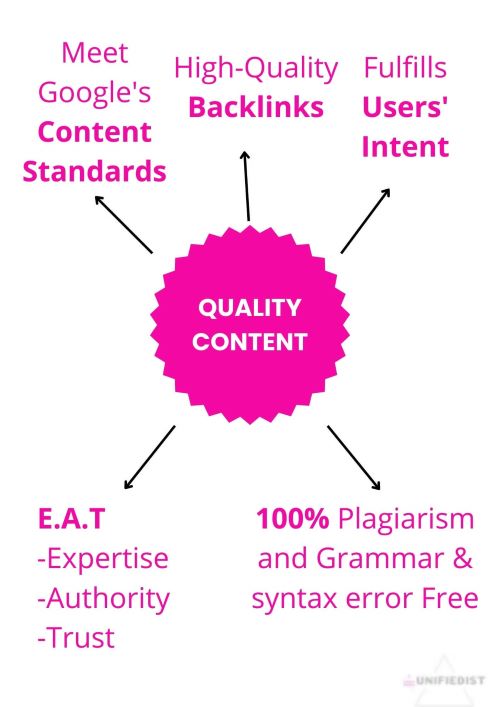
The definition of quality content varies according to the purpose of a page. However, in a simple term, if a page has 100% unique content (i.e. plagiarism free, grammar and syntax error free), fulfills the purpose of user’s intent, follows the Google guidelines, and high-quality backlinks is known as the page has quality content.
What are the forms and shapes of the SaaS Content?
The unique and high-quality to promote the SaaS products could be of any type from the list mentioned below:
1. Blog
2. Videos
3. Podcasts
4. How-to Guide
5. eBooks
6. Case Studies
7. Tutorial
8. Interactive tools
9. Social Media Post
10. Infographics
Why Does Quality Content Matter A Lot?
Creating quality content can bring numerous benefits to your SaaS business. Here are some of the ways it can help:
1. It helps in improving the SEO rankings: Recently, Google’s helpful content update has come regarding content creation that clearly says that Google gives priority to original and useful content that addresses the searcher’s query.

Content should be crafted for users first and not only for SEO ranking. If you do this, you are definitely going to be outranked by your competitors. Therefore, user oriented high-quality content is crucial for search engine optimization (SEO) of your website.
2. Spruce up brand’s image: Good content can improve your brand’s image and establish you as an industry expert. It can also generate discussions, increase engagement, and build trust among your audience.
3. It leads to more conversion: By providing informative content, you can educate your audience about your product or service, and attract leads that are more likely to convert into paying customers.
4. Helps visitors into paying customers: Content can be a powerful tool to introduce your offerings to potential customers, and guide them through the buying journey. Well-crafted content can help convert visitors into paying customers.
5. It enhances user experience: High-quality content can enhance the customer experience by helping users onboard and make the most out of your products. This can reduce churn rates and increase customer loyalty.
6. It increases User Engagement: Compelling content can keep users coming back to your website, making it an effective strategy to generate returning visitors and increase engagement.
It’s important to note that there is no one-size-fits-all approach to creating good content. Each business and industry has unique needs, and you will need to customize your content strategy accordingly. However, all high-quality content shares some common traits that make it useful, informative, and engaging for the target audience.
What is SaaS Content Writing?
SaaS content writing refers to the creation of content that effectively communicates to your target audience how your product can address their needs and solve their problems.
This process aims to showcase how your product can simplify their lives and make it easier for them to achieve their goals. Effective SaaS content writing involves educating your audience and demonstrating how they can use your product to achieve their desired outcomes.
In summary, SaaS content writing is a vital tool for businesses that want to effectively communicate the benefits of their product to potential customers.
Difference Between SaaS Content & Other Content Creation
SaaS content writing differs from general writing in several ways.
SaaS content writing focuses specifically on creating content that educates and demonstrates how a product can solve a particular problem or address a specific need. It is aimed at a target audience and is designed to be persuasive in nature, encouraging the reader to take a specific action, such as trying out a product or signing up for a service.
Content writing other than SaaS content writing, on the other hand, is more broad in scope and can cover a wide range of topics. It may not necessarily be persuasive in nature and may not be aimed at a specific target audience. While both types of writing involve creativity and skill, SaaS content writing requires a more strategic and targeted approach.
So, you’ve understood well about the quality content and its importance for the success of business.
Now,
Let’s dive in to know how to create high-quality content that converts step-by-step.
SaaS Content Writing Tips (step-by-step)
1. Know Customer Pain Points
2. Find Competitor’s Top Performing Pages & Ads Copies
3. Find User Intent Keywords for Your SaaS Product
4. Align SaaS Content As Per Your Business Goal
5. Choose the Correct Format
6. Craft Headline Into A Masterpiece
7. Use Power Words
8. Increase Content Readability Score
9. Check for Plagiarism
10. Promote the Content
11. Measure the Content Performance
12. Update Content
Know Customer Pain Points
As a SaaS business owner, understanding your customers’ pain points is critical to developing a successful product that meets their needs. Pain points are the specific problems or challenges that your customers face and need to be solved.
How to Know & Resolve Your Customer’s Pain Points?
To identify your customer’s pain points, you can conduct surveys, analyze customer feedback, and engage with your customers through social media channels.
Fundamentally, there are four types of pain points which are – productivity, process, financial, and support pain points.
Now, let’s understand how to resolve the above mentioned pain points with examples :
By Conducting Qualitative and Quantitative Sales Research:-
Many teams engage in a combination of qualitative and quantitative research methods to identify potential pain points. Qualitative research involves eliciting detailed and nuanced responses by asking open-ended questions, while quantitative research generates numerical and statistical data through standardized questions.
Sales and marketing teams can utilize different methods to generate these insights. For example, sales teams can inquire about the most common pain points during discovery calls with prospects, while marketing teams can conduct research and surveys to identify prevalent challenges.
For example;
The marketing team at Yesware conducted qualitative research by distributing a survey to salespeople to determine their most significant sales challenges at present:
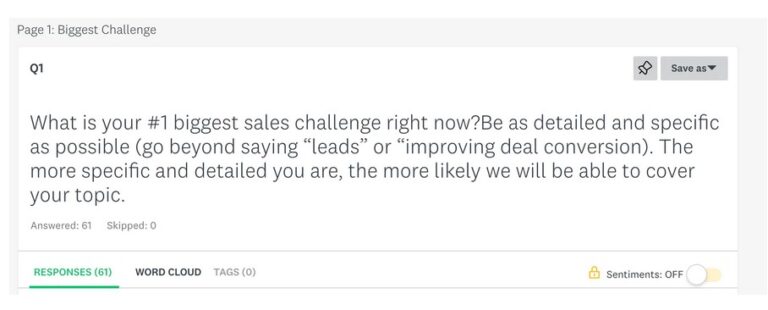
By talking to prospects in an Open-Ended Questions Session:
When engaging with a potential customer, the success of the interaction hinges on the ability to ask pertinent questions. The reason a prospect may have initiated the purchasing process in the first place is due to a business problem that requires resolution
Consequently, the goal is to identify the above issue, and one effective approach is to encourage the prospect to express themselves freely.
Open-ended questions serve as an excellent tool for achieving this aim. By avoiding queries that can be answered with a simple “yes” or “no,” and instead asking questions that encourage more detailed responses, one can elicit valuable information from the prospect.
For example;
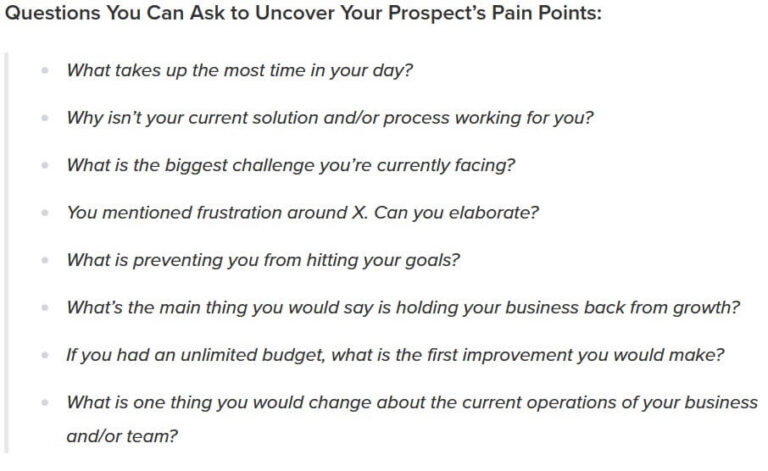
Ultimately, addressing your customer’s pain points is a crucial aspect of building a successful SaaS business and cultivating a loyal customer base.
Find Competitor’s Top Performing Pages
As per the latest data received from Crunchbase, there are around 27933 SaaS companies listed.
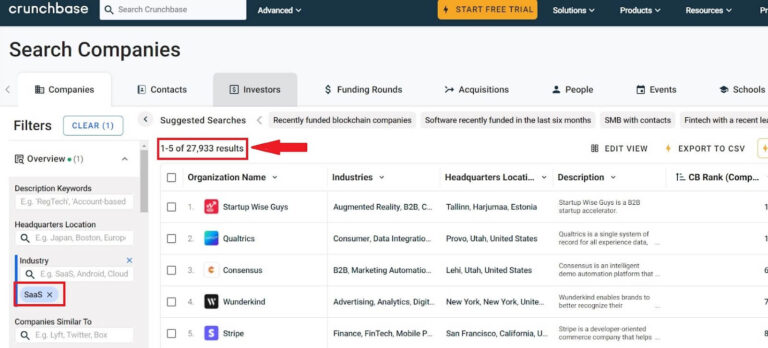
You can imagine the potential of the SaaS market and importance of unique content.
One way to improve your marketing strategy is by analyzing your competitor’s top-performing pages and ad copies.
Here are some steps to help you find your competitor’s top-performing pages and ad copies:
Use Tools to Analyze Competitor’s Pages
Once you have a list of competitors, you can use tools like Ahrefs, SEMrush, or SimilarWeb to analyze their website’s traffic and top-performing pages. These tools can provide insights into their organic search rankings, keyword strategy, and the most visited pages on their website.
Analyze Competitor’s Ad Copies
Apart from analyzing their website’s performance, it is also crucial to analyze your competitor’s ad copies. You can use tools like Adbeat, SpyFu, or SEMrush to track their ad campaigns across various platforms. These tools can provide you with detailed information on the ad copy, targeting strategy, and engagement metrics. Use Facebook’s Ad Library to find your competitor’s top-performing ad copies. Look for ads that have been running for an extended period and have a high engagement rate.
Analyze Data and Make Adjustments
After analyzing your competitor’s top-performing pages and ad copies, you need to analyze the data and make adjustments to your own strategies. Determine which tactics are working for your competitors and try to integrate those into your own campaigns. Keep in mind that you should not copy their strategies outright, but rather use them as inspiration to create unique and effective campaigns.
Pro Tip: Pay close attention to the content on these pages. Look for patterns and themes that resonate with your audience, such as specific keywords, topics, or formats. Take note of any calls to action (CTAs) used on these pages. Analyze the language, placement, and design of these CTAs to determine what’s driving conversions for your competitors.
Find User Intent Keywords for Your SaaS Product
When it comes to promoting your SaaS product, one of the key factors that determine its success is the ability to attract the right audience. However, to attract the right audience, you need to know what they’re searching for. This is where keyword research comes in handy.
Let me tell you how you can find the profitable keywords for your SaaS business. Here are some of the best keyword research tools you can use:
Analyze your competitors:
Look at the keywords they are targeting and the content they are creating. This will give you an idea of the type of keywords that are working in your industry.
Use Google Keyword Planner:
Google Keyword Planner is a free tool that helps you research keywords and estimate their performance. It provides valuable information on the search volume, competition, and cost-per-click of specific keywords, allowing you to optimize your website’s content for the keywords that matter most to your business.
For Example;
If you’re having a Saas business offering event management software, here is the way you can find the profitable keywords with search volume, competition, and so on.
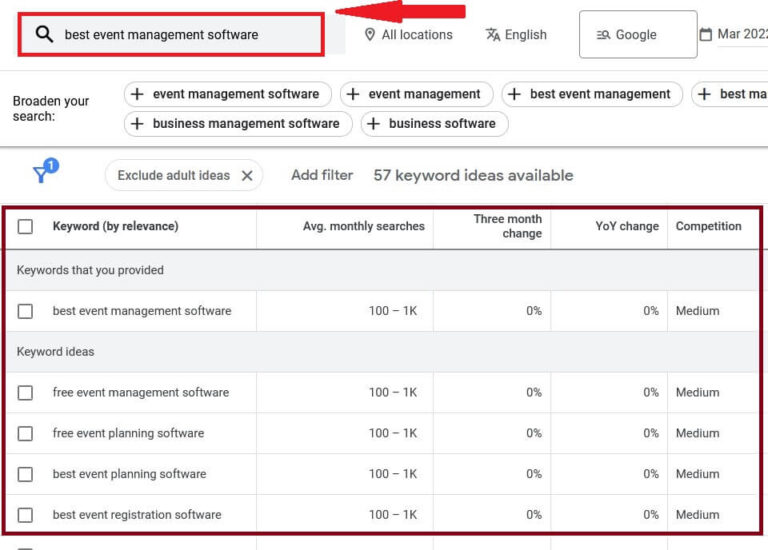
Use Google Auto Suggestion:
Google Auto Suggestion is a great tool for finding user intent keywords. When you start typing a search query into Google, it will suggest related keywords based on what other users are searching for. Take note of these suggestions and use them to optimize your website and marketing campaigns.
For example;
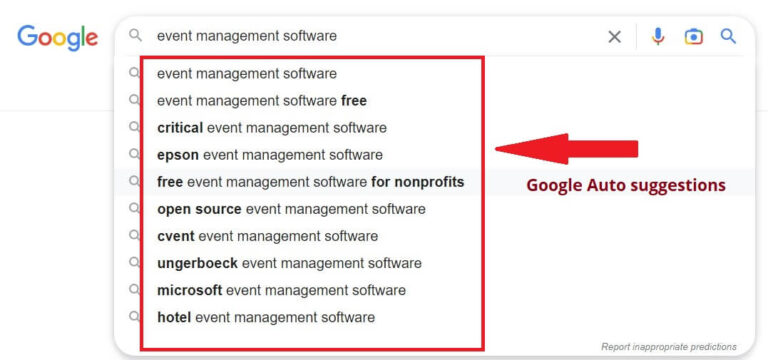
Paid Tools like Ahrefs, or SEMrush:
Use tools like Ahrefs, or SEMrush to find keywords that are relevant to your product and your target audience. Make sure to focus on long-tail keywords, as they are more specific and have a higher chance of converting. These tools are renowned for keywords research in the SEO industry.
Read our step-by-step guide to SaaS keyword research, if you are unfamiliar with the keyword research process.
Align SaaS Content As Per Your Business Goal
The main purpose of content creation is to generate business outcomes such as sales or leads. If content doesn’t serve this purpose, then there is no point in creating it. To create effective content, you must first identify your goals, which is a crucial step in any SaaS content strategy.
Examples of SaaS content marketing goals include generating more leads or sales, improving retention, or increasing social media engagement. However, since businesses have limited resources, it’s essential to look at the return on investment (ROI) of SaaS content marketing and prioritize the pieces with the highest potential.
One way to identify the best opportunities is by using the content marketing funnel. This funnel represents the different stages a potential customer goes through to become a customer.
The lower a person is in the funnel, the closer they are to conversion.
If you’re on a tight budget and need to increase conversions, prioritize pieces lower in the funnel, such as product comparisons or case studies. If you want to reach more users, generate awareness, and strengthen your brand, prioritize pieces higher in the funnel, such as studies or more generic, informative articles.
Ideally, your content plan should cover all three stages of the funnel. However, using this framework can help you allocate resources more efficiently.
For more guidance, you can read our complete guide to the SaaS content strategy.
Choose the Correct Content Format
When it comes to creating content for your Software as a Service (SaaS) business, choosing the right format is key.
With so many options available such as Blog, Video, Case studies, Whitepapers, Infographics, and so on, it can be overwhelming to determine which one is best for your particular audience and message.
Overall, the best content format to promote SaaS products is through Blog. It is one of the best sections of SaaS content marketing strategy and is widely used.
Draft Headline Like a Pro
David Ogilvy’s statement regarding effective advertising headlines is as follows:
“Never use tricky or irrelevant headlines… People read too fast to figure out what you are trying to say.”
So, how to optimize and test the headlines.
Here is a perfect tool that makes your life easier. It not only helps you optimize the headline but also provides you with the score of your headline. Score tells how your headline will perform among your competitors.
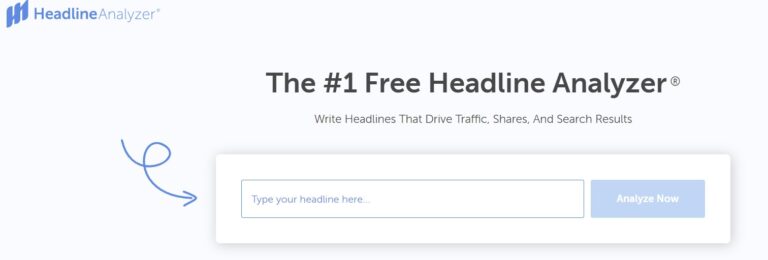
Use Power Words
In the copywriting world, experts say that – power words in the headline or in copy increase the sales by 80% more than usual headlines. Try to incorporate power words in your content.
Increase Content Readability Score
Are you finding it hard to get your point across in a concise and clear manner? Well, worry not!
Hemingway, the famous writing tool, is here to help you.
Hemingway is a web-based app that analyzes your writing and suggests ways to make it more readable. It is a great tool for bloggers, copywriters, and anyone who wants to improve their writing skills.
Make sure, your Grade Score is below 9.
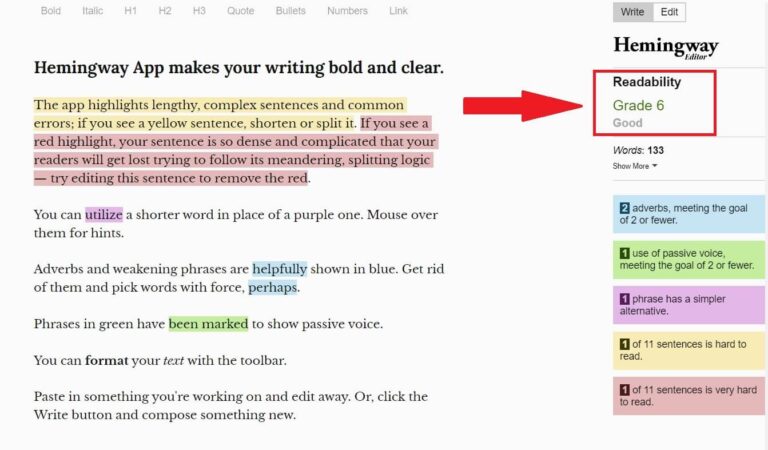
Check for Plagiarism
One of the best tools for checking plagiarism is Grammarly. Grammarly is a popular tool that not only checks for grammatical errors but also checks for plagiarism. The tool scans the text against a vast database of over 16 billion web pages, academic papers, and other sources to ensure that the content is original.
Another useful tool for checking for plagiarism in SaaS content is Copyscape.
Duplication can lead to penalization by Google algorithm. Tools like Grammarly, Copyscape, and Quetext help you get 100% unique content by removing duplication in the content.
Promote the Content
Creating valuable content is only half the battle. The other half is making sure your target audience actually sees it.
That’s where link building comes in.
But not all link building strategies are created equal.
SaaS link building techniques can help you promote your content and drive traffic to your website
Measure the Content Performance
Fortunately, Google Analytics can help you measure the performance of your content and make data-driven decisions to improve it. You can start tracking the performance of your content by looking at metrics such as pageviews, bounce rate, time on page, and conversion rate.
Don’t be confused about these terms. Let me explain in a simple way:
1. Bounce Rate: Bounce rate is the percentage of visitors who leave a website after viewing only one page.
2. Pageviews: The total number of pages viewed by the visitors in a course of time.
3. Time on Page (or Duration on Page): The average amount of time that visitors spend on a page of your site.
4. Conversion Rate: Conversion rate is the percentage of visitors who take a desired action, such as making a purchase, filling up the contact form, or email sign up etc.
Update Content
Ensuring content relevance is a vital aspect of maximizing user engagement and search engine optimization. Outdated content holds diminished potential to yield positive business outcomes, such as sales or lead generation. As such, it is imperative to regularly update and refine content quality.
This is due to one of the top reasons being – Fresh Content is a Google ranking factor as it has already been confirmed.
Reason to Invest in Content Creation
In today’s digital age, creating quality content has become a necessity for any business looking to stand out from the crowd. Whether you are a small business owner or a large corporation, there are several reasons why investing in content creation is worth your time and money.
Here are some of them:
Boosts SEO and Organic Traffic: One of the primary reasons to invest in content creation is to boost your search engine optimization (SEO) and organic traffic. By consistently creating high-quality content, you can target specific keywords and topics that your target audience is searching for. This, in turn, can help your website rank higher in search engine results pages, leading to more organic traffic to your website.
Establishes You as an Authority in Your Industry: Creating quality content allows you to showcase your knowledge and expertise in your industry. By consistently producing content that offers value to your audience, you can establish yourself as an authority in your field. This, in turn, can help build trust and credibility with your audience, leading to more conversions and sales.
Provides Value to Your Audience: Investing in content creation also allows you to provide value to your audience. By creating content that answers their questions, solves their problems, or entertains them, you can build a loyal following of customers and fans. This can also help increase brand awareness and word-of-mouth marketing.
Creates Shareable Content: Another benefit of investing in content creation is the potential for your content to be shared across social media and other platforms. By creating shareable content, you can increase your reach and exposure to new audiences. This can lead to increased brand awareness and even more organic traffic to your website.
Long-Term Benefits: Finally, investing in content creation offers long-term benefits. Unlike paid advertising, which stops producing results once the campaign ends, content creation can continue to generate traffic and leads long after the initial creation. By creating evergreen content that remains relevant and useful to your audience, you can continue to reap the benefits for years to come.
Final Thought
This article comprehensively covers unique content creation techniques. However, creating unique content is not REALLY an easy task as it seems to be when it comes to promoting your SaaS products. It needs proper research, and SaaS marketing expert guidance.
Looking for a SaaS Marketing Expert?
If you’re running a SaaS business and have not received results as expected, and you’re looking to generate leads, but you need a proper consultation.
Now what are you waiting for?
Book a free consultation with our SaaS marketing consultant.

